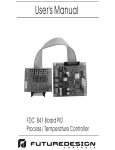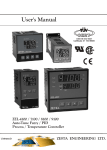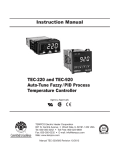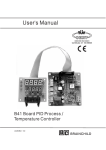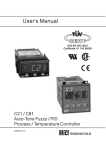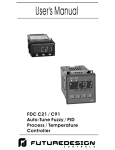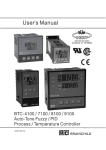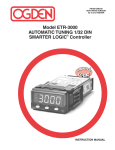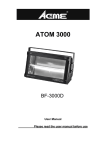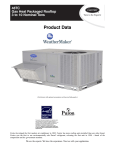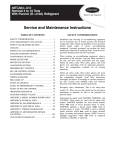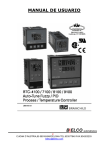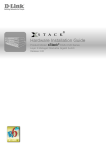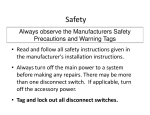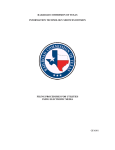Download TC48-TC96 User`s Manual
Transcript
R The Symbol calls attention to an operating procedure, practice, or the like, which, if not correctly performed or adhered to, could result in personal injury or damage to or destruction of part or all of the product and system. Do not proceed beyond a warning symbol until the indicated conditions are fully understood and met. Installers Read Chapter 1, 2 System Designer Read All Chapters Expert User Read Page 12 NOTE: It is strongly recommended that a process should incorporate a LIMIT CONTROL like L91 which will shut down the equipment at a preset process condition in order to preclude possible damage to products or system. Some programming parameters shown in this manual may not be available on currently offered models. Information in this user's manual is subject to change without This manual is applicable for the products with software version 23 and later version. Copyright September 2007, Eaton Corporation, all rights reserved. No part of this publication may be reproduced, transmitted, transcribed or stored in a retrieval system, or translated into any language in any form by any means without the written permission of Eaton Corporation. 2 Contents Page No Page No Chapter 1 Overview Chapter 4 Applications 1-1 General -------------------------5 4-1 Heat Only Control with Dwell Timer ------------------45 1-2 Ordering Code ---------------8 1-3 Keys and Displays ---------9 4-2 Cool Only Control ------------46 1-4 Menu Overview -------------11 1-5 Parameter Descriptions ---12 Chapter 5 Calibration --------47 Chapter 2 Installation Chapter 6 Specifications ----48 Unpaking ----------------------19 Mounting ----------------------19 Wiring precautions ----------21 Appendix Power Wiring -----------------24 A-1 Error Codes ------------------54 Sensor Installation A-2 Warranty ----------------------55 Guidlines----------------------24 2-6 Sensor Input Wiring ---------25 2-7 Control Output Wiring ------25 2-8 Alarm Wiring -----------------27 2-1 2-2 2-3 2-4 2-5 Chapter 3 Programming 3-1 Lockout ------------------------28 3-2 Signal Input -------------------28 3-3 Control Outputs --------------29 3-4 Alarm ---------------------------34 3-5 Configure User Menu -------35 3-6 Ramp ---------------------------36 3-7 Dwell Timer -------------------37 3-8 PV Shift ------------------------38 3-9 Digital Filter -------------------39 3-10 Failure Transfer -------------40 3-11 Auto-tuning ------------------41 3-12 Manual tuning ---------------42 3-13 Manual Control -------------43 3 Figures & Tables Page No Figure 1.1 Fuzzy Control Advantage ----------------------------------------------------------------6 Figure 1.2 Front Panel Description -----------------------------------------------------------------10 Figure 1.3 Display of Initial Stage -------------------------------------------------------------------10 Figure 2.1 Mounting Dimensions -------------------------------------------------------------------20 Figure 2.2 Lead Termination for TC 96---------------------------------------------22 Figure 2.3 Lead Termination for TC 48-------------------------------------------------------------22 Figure 2.4 Rear Terminal Connection for TC 96------------------------------------------------22 Figure 2.5 Rear Terminal Connection for TC 48------------------------------------------------23 Figure 2.6 Power Supply Connections ------------------------------------------------------------24 Figure 2.7 Sensor Input Wiring ----------------------------------------------------------------------25 Figure 2.8 Output 1 Relay or to Drive Load---------------------------------------------------25 Figure 2.9 Output 1 Relay or to Drive Contactor---------------------------------------------26 Figure 2.10 Output 1 Pulsed Voltage to Drive SSR----------------------------------------------26 Figure 2.11 Output 1 Linear Current ---------------------------------------------------------------27 Figure 2.12 Alarm Output to Drive Load ----------------------------------------------------------27 Figure 2.13 Alarm Output to Drive Contactor ----------------------------------------------------27 Figure 3.1 Conversion Curve for Linear Type Process Value ---------------------------------29 Figure 3.2 Heat Only ON-OFF Control ------------------------------------------------------------30 Figure 3.3 Output 2 Deviation High Alarm --------------------------------------------------------33 Figure 3.4 Output 2 Process Low Alarm ----------------------------------------------------------33 Figure 3.5 RAMP Function ---------------------------------------------------------------------------36 Figure 3.6 Dwell Timer Function --------------------------------------------------------------------37 Figure 3.7 PV Shift Application ----------------------------------------------------------------------38 Figure 3.8 Filter Characteristics ---------------------------------------------------------------------39 Figure 3.9 Effects of PID Adjustment -------------------------------------------------------------44 Figure 4.1 Heat Control Example -------------------------------------------------------------------45 Figure 4.2 Cooling Control Example ---------------------------------------------------------------46 Table Table Table Table 4 1.1 Display Form of Characters ------------------------------------------------------------10 3.1 Heat-Cool Control Setup Value ---------------------------------------------------------29 3.2 PID Adjustment Guide --------------------------------------------------------------------43 A.1 Error Codes and Corrective Actions --------------------------------------------------54 Chapter 1 Overview 1-1 General The Fuzzy Logic plus PID microprocessor-based controller series, incorporate two bright, easy to read 4-digit LED displays, indicating process value and set point value. The Fuzzy Logic technology enables a process to reach a predetermined set point in the shortest time, with the minimum of overshoot during power-up or external load disturbance. The TC48 is a 1/16 DIN size panel mount controller. The TC96 is a 1/8 DIN size panel mount controller. These units are powered by 11-26 or 90-250 VDC /VAC supply, incorporating a 2 amp control relay output as standard. The units are fully programmable for PT100 and thermocouple types J,K, T, E, B, R, S, N, L with no need to modify the unit. The input signal is digitized by using a 18-bit A to D converter. Its fast sampling rate allows the unit to control fast processes. By using proprietary Fuzzy modified PID technology, the control loop will minimize the overshoot and undershoot in a shortest time. The following diagram is a comparison of results with and without Fuzzy technology. 5 Temperature PID control when properly tuned PID + Fuzzy control Set point Figure 1.1 Fuzzy Control Advantage Warm Up Load Disturbance Time High Accuracy The series are manufactured with custom designed ASIC(Application Specific Integrated Circuit ) technology which contains a 18-bit A to D converter for high resolution measurement ( true 0.1 °F resolution for thermocouple and PT100 ) and a 15-bit D to A converter for linear current or voltage control output. The ASIC technology provides improved operating performance, low cost, enhanced reliability and higher density. Fast Sampling Rate The sampling rate of the input A to D converter reaches 5 times/second. The fast sampling rate allows this series to control fast processes. Fuzzy Control The function of Fuzzy control is to adjust PID parameters from time to time in order to make manipulation output value more flexible and adaptive to various processes. The results is to enable a process to reach a predetermined set point in the shortest time, with the minimum of overshoot and undershoot during power-up or external load disturbance. 6 Auto-tune The auto-tune function allows the user to simplify initial setup for a new system. A clever algorithm is provided to obtain an optimal set of control parameters for the process, and it can be applied either as the process is warming up ( cold start ) or as the process has been in steady state ( warm start ). Lockout Protection According to actual security requirement, one of four lockout levels can be selected to prevent the unit from being changed by unauthorized personnel. Bumpless Transfer Bumpless transfer allows the controller to continue to control by using its previous value as the sensor breaks. Hence, the process can be controlled temporarily in open loop mode. Soft-start Ramp The ramping function is performed during power up as well as any time the set point is changed. It can ramp up or ramp down. The process value will reach the set point with a predetermined constant rate. Digital Filter A first order low pass filter with a programmable time constant is used to improve the stability of process value. This is particularly useful in certain applications where the process value is too unstable to be read. SEL Function The units have the flexibility for user to select those parameters which are most significant to him and put these parameters in the front of display sequence. Up to 8 parameters can be selected to allow the user to build his own display sequence. 7 1-2 Ordering Code TC 48TC 96- Power Input 4: 90 - 250 VAC, 50/60 HZ 5: 11 - 26 VAC or VDC Options 0: Panel mount IP50 standard 1: Panel mount IP65 water resistant gasket installed Communications 0: None Signal Input 1: Standard Input Thermocouple: J, K, T, E, B, R, S, N, L RTD: PT100 DIN, PT100 JIS Alarm 0: None 1: Form C relay 2A/240VAC Output 2 0: None Output 1 1: Relay rated 2A/240VAC 2: Pulsed voltage to drive SSR, 5V/30mA 3: Isolated 4 - 20mA / 0 - 20mA NOTE: Not all options are currently available with all models. 8 1- 3 Keys and Displays KEYPAD OPERATION SCROLL KEY : This key is used to select a parameter to be viewed or adjusted. UP KEY : This key is used to increase the value of selected parameter. DOWN KEY : This key is used to decrease the value of selected parameter. RESET KEY : R This key is used to: 1. Revert the display to the process value. 2. Reset the latching alarm, once the alarm condition is removed. 3. Stop the manual control mode, auto-tuning mode, and calibration mode. 4. Clear communication error and auto-tuning error messages. 5. Restart the dwell timer when the dwell timer has been timed out. 6. Enter the manual control menu during failure mode occurrances. for 5 seconds or longer . ENTER KEY : Press Press for 5 seconds to: 1. Enter setup menu. The display shows . 2. Enter manual control mode when manual control mode is selected. 3. Enter auto-tuning mode when auto-tuning mode selected. 4. Perform calibration to a selected parameter during the calibration procedure. Press for 6.2 seconds to select manual control mode. Press for 7.4 seconds to select auto-tuning mode. Press for 8.6 seconds to select calibration mode. is 9 Alarm Indicator Upper Display, to display process value, menu symbol and error code etc. Process Unit Indicator Output 2 Indicator Output 1 Indicator OP1 OP2 ALM C Manual Mode Indicator Auto-tuning Indicator F Lower Display, to display set point value, parameter value or control output value etc. MAN AT R 4 Buttons for control setup and set point adjustment. TC 48 Figure 1.2 Front Panel Description Table 1.1 Display Form of Characters A B C E F G H h c D I J K L M N O P Q R OP1 OP2 ALM C F X Y Z ? = Display program code of the product for 2.5 seconds. The lower display shows program no. 6 for TC 48 with version 24. The program no. for TC 96 is 11. . MAN AT R TC 48 10 S T U V W Figure 1.3 Display of Initial Stage 1- 4 Menu Overview User menu Setup menu Manual Mode 7.4 sec. 6.2 sec. 5 sec. Auto-tuning Mode Calibration Mode 8.6 sec. 9.8 sec. PV, SV *2 SP2 SP3 INPT UNIT DP PB TI TD CYC1 ADDR *1 LOCK INPT UNIT DP INLO INHI SP1L SP1H SHIF FILT PB TI TD OUT1 O1TY O1FT O1HY CYC1 OFST RAMP RR OUT2 O2TY O2FT O2HY CYC2 CPB DB ALFN ALMD ALHY ALFT COMM ADDR BAUD DATA PARI STOP RELO REHI SEL1 SEL2 SEL3 SEL4 SEL5 SEL6 SEL7 SEL8 H_ _ _ C_ _ _ Release then press for 5 seconds to start auto-tuning mode. Press for 5 seconds to start manual control. *3 ADLO ADHI RTDL RTDH CJLO CJHI Press for 5 seconds to perform calibration. Applying these modes will break the control loop and change some of the previous setting data. Make sure that the system is able to operate in these modes. *1: The flow chart shows a complete listing of all parameters. For actual application the number of available parameters depends on setup conditions, and should be less than that shown in the flow chart. You can select up to 8 parameters to put *2: in the user menu by using SEL1~SEL8 at the bottom of setup menu. Release , then press for 2 seconds *3: minimum, but not more than 3 seconds, to enter the calibration menu. The user menu shown in the flow chart corresponds to the default settings for SEL parameters SEL1 to SEL8. SP3 will be hidden if NONE is selected for ALFN. SP2 will be hidden if alarm function is not selected for OUT2. Unused parameters will be hidden even if they are selected by SEL parameters. 11 1-5 Parameter Descriptions Parameter Notation Range Parameter Description SP1 Set point for output 1 Low: SP1L SP2 Set point for output 2 when output 2 performs alarm function Low: -19999 High :45536 SP3 Set point for alarm or dwell timer output Low: -19999 High: 45536 0 1 LOCK Select parameters to be locked 2 3 0 1 2 3 Input sensor selection : No parameter is locked : Setup data are locked : Setup data and User data except Set point are locked : All data are locked 6 : S type thermocouple 7 : N type thermocouple 8 9 : L type thermocouple : PT 100 ohms DIN 10 : PT 100 ohms JIS 11 : 4 - 20 mA linear curve curve 13 14 15 16 17 12 10.0 C (18.0F) 10.0 C (18.0 F) 0 : T type thermocouple : E type thermocouple : B type thermocouple : R type thermocouple 12 25.0 C (77.0 F) : J type thermocouple : K type thermocouple 5 4 INPT High :SP1H Default Value current input : 0 - 20 mA linear current input : 0 - 60 mV linear millivolt input : 0 - 1V linear voltage input : 0 - 5V linear voltage input : 1 - 5V linear voltage input : 0 - 10V linear voltage input 1 (0) Parameter Notation UNIT DP Input unit selection Decimal point selection Default Value Range Parameter Description 0 : Degree C unit 1 : Degree F unit 2 : Process unit 0 : No decimal point 1 : 1 decimal digit 2 : 2 decimal digits 3 : 3 decimal digits 0 (1) 1 -17.8 C ( 0F ) INLO Input low scale value Low: -19999 High: 45486 INHI Input high scale value Low: INLO+50 93.3 C High: 45536 (200.0 F) SP1L Low limit of set point value Low: -19999 High: 45536 Low: SP1L 537.8 C High: 45536 (1000 F) SP1H High limit of set point value SHIF PV shift (offset) value FILT Filter damping time constant of PV -200.0 C Low: (-360.0 F) C High: ( 200.0 360.0 F) 0 : 0 second time 1 High: : 0.2 second time 2 : 0.5 second time 3 : 1 second time 4 : 2 seconds time 5 : 5 seconds time 6 : 7 : 8 : 9 : -17.8 C (0 F) 0.0 constant constant constant constant constant 2 constant 10 seconds time constant 20 seconds time constant 30 seconds time constant 60 seconds time constant 13 Parameter Notation Parameter Description PB Proportional band value Low: 0 TI Integral time value Low: 0 High: 1000 sec 100 TD Derivative time value Low: 0 High: 360.0 sec 25.0 OUT1 O1TY Range Output 1 signal type 500.0 LC 10.0 C High: (900.0 LF) (18.0 F) 0 : Reverse (heating ) 1 : Direct (cooling) Output 1 function control action 0 : Relay output 1 : Solid state relay drive output 2 : Solid state relay output 3 : 4-20 mA current module 4 : 0 - 20 mA current 5 : 0 - 1V voltage 6 : 0 - 5V voltage 7 : 1 - 5V voltage 8 : 0 - 10V voltage module module module module Output 1 failure transfer mode O1HY Output 1 ON-OFF control hysteresis Low: 0.1 High: 50.0 C(90.0 F) CYC1 Output 1 cycle time Low: 0.1 High: 90.0 sec. OFST Offset value for P control Low: 0 14 High: 100.0 % 0 : No Ramp Function 1 : Use unit/minute as Ramp Rate : Use unit/hour as Ramp Rate 2 0 module O1FT Ramp function selection 0 control action Select BPLS ( bumpless transfer ) or 0.0 ~ 100.0 % to continue output 1 control function if the sensor fails, or select OFF (0) or ON (1) for ON-OFF control. RAMP Default Value 0 0.1 C (0.2 F) 18.0 25.0 0 Parameter Parameter Description Notation RR OUT2 O2TY O2FT Range Ramp rate 500.0 C High: (900.0 F) Low: 0 0 : Output 2 No Function 2 : Deviation High Alarm 3 : Deviation Low Alarm 6 : Process High Alarm 7 : Process Low Alarm 8 : Cooling PID Function Output 2 function Output 2 signal type Output 2 failure transfer mode 0 : Relay output 1 : Solid state relay 2 : Solid state relay 3 : 4 - 20 mA current 4 : 0 - 20 mA current 5 : 6 : 7 : 8 : Default Value 0.0 2 drive output output module 0 module 0 - 1V voltage module 0 - 5V voltage module 1 - 5V voltage module 0 - 10V voltage module Select BPLS ( bumpless transfer ) or 0.0 ~ 100.0 % to continue output 2 control function if the sensor fails, or select ON (0) or OFF (1) for alarm function. 0 O2HY Output 2 hysteresis value when output 2 performs alarm function Low: 0.1 CYC2 Output 2 cycle time Low: 0.1 High: 90.0 sec. 18.0 CPB Cooling proportional band value Low: 50 High: 300 % 100 50.0 C High: (90.0 F) 0.1 C (0.2 F) 15 Parameter Parameter Description Notation DB ALFN Range Heating-cooling dead band (negative value= overlap) Alarm function for alarm output Low: -36.0 0 :No alarm function 1 :Dwell timer action 2 :Deviation high alarm 3 :Deviation low alarm 4 :Deviation band out of band alarm :Deviation band in band alarm :Process value high alarm :Process value low alarm 5 6 7 ALMD 0 : Normal alarm 1 : Latching alarm Alarm operation mode 2 3 ALHY Hysteresis control of alarm ALFT Alarm failure transfer mode Low: 0.1 0 COMM 16 Communication function High: 36.0 % 1 Default Value 0 2 action action : Hold alarm action 0 Latching & Hold : action 50.0 C High: (90.0 F) : Alarm output ON as unit fails : Alarm output OFF as unit fails 0 : No communication 1 : Modbus RTU mode protocol 2 :4-20mA retransmission output 3 :0-20mA retransmission output 4 :0-5V retransmission output 5 :1-5V retransmission output 6 :0-10V retransmission output 0.1 C (0.2 F) 0 1 Parameter Parameter Description Notation ADDR BAUD Address assignment of digital communication Baud rate of digital communication DATA Data bit count of digital communication PARI Parity bit of digital communication Range Low: 1 Default Value High: 255 0 : 2.4 Kbits/s baud rate 1 : 4.8 Kbits/s baud rate 2 : 9.6 Kbits/s baud rate 3 : 14.4 Kbits/s baud rate 4 : 19.2 Kbits/s baud rate 5 : 28.8 Kbits/s baud rate 6 : 38.4 Kbits/s baud rate 0 : 7 data bits 1 : 8 data bits 0 : Even parity 1 : Odd parity 2 : No parity bit 0 : One stop bit 1 : Two stop bits 2 1 0 STOP Stop bit count of digital communication RELO Retransmission low scale value Low: -19999 High: 45536 0.0 C (32.0 F) REHI Retransmission high scale value Low: -19999 High: 45536 100.0 C (212.0 F) SEL1 0 : No parameter selected 1 : LOCK is put ahead 2 : INPT is put ahead Select 1'st parameter for 3 user menu 4 : UNIT is put ahead 5 : SHIF is put ahead 6 : PB is put ahead 7 : TI is put ahead 0 2 : DP is put ahead 17 Prameter Notation SEL1 Range Parameter Description Select 1st parameter for user menu 8 : TD is put ahead 9 : O1HY is put ahead 10 : CYC1 is put ahead 11 : OFST is put ahead 12 : RR is put ahead 13 : O2HY is put ahead 14 : CYC2 is put ahead 15 : CPB is put ahead 16 : DB is put ahead 17 : ADDR is put ahead 18 : ALHY is put ahead Default Value 2 SEL2 Select 2nd parameter for user menu Same as SEL1 3 SEL3 Select 3rd parameter for user menu Same as SEL1 4 SEL4 Select 4th parameter for user menu Same as SEL1 6 SEL5 Select 5th parameter for user menu Same as SEL1 7 SEL6 Select 6th parameter for user menu Same as SEL1 8 SEL7 Select 7th parameter for user menu Same as SEL1 10 SEL8 Select 8th parameter for user menu Same as SEL1 17 18 Chapter 2 Installation Dangerous voltages capable of causing death may be present in this instrument. Before installation or beginning any cleaning or troubleshooting procedures the power to all equipment must be switched off and isolated. Units suspected of being faulty must be disconnected and removed to a properly equipped workshop for testing and repair. Component replacement and internal adjustments must be made by a qualified maintenance person only. This instrument is protected throughout by Double . To minimize the possibility of fire or shock Insulation hazards, do not expose this instrument to rain or excessive Do not use this instrument in areas under hazardous conditions such as excessive shock, vibration, dirt, moisture, corrosive gases or oil. The ambient temperature of the areas should not exceed the maximum rating specified in Chapter 6. Remove stains from this instrument using a soft, dry cloth. Don't use harsh chemicals, volatile solvents, such as thinners or strong detergents to clean the instrument in order to avoid deformation or discoloration. 2-1 Unpacking Upon receipt of the shipment remove the unit from the carton and inspect the unit for shipping damage. If any damage due to transit , report and claim with the carrier. Write down the model number, serial number, and date code for future reference when corresponding with our service center. The serial number (S/N) and date code (D/C) are labeled on the box and the housing of control. 2-2 Mounting Make panel cutout to dimension shown in Figure 2.1. Remove both mounting clamps and insert the controller into panel cutout. Reinstall the mounting clamps. Gently tighten the screws in the clamp until the controller front panel is fitted snugly in the cutout. 19 92 mm Figure 2.1 Mounting Dimensions TC 96 Panel 45 mm 65 mm Panel 45 mm 45 mm Panel Cutout 11.5mm 20 TC 48 104.8mm 2 - 3 Wiring Precautions Before wiring, verify the label for correct model number and options. Switch off the power while checking. Care must be taken to ensure that maximum voltage rating specified on the label is not exceeded. It is recommended that power to these units be protected by fuses or circuit breakers rated at the minimum value possible. All units should be installed inside a suitably grounded metal enclosure to prevent live parts being accessible by human hands and metal tools. All wiring must conform to appropriate standards of good practice and local codes and regulations. Wiring must be suitable for voltage, current, and temperature rating of the system. Beware not to over-tighten the terminal screws. The torque should not exceed 1 N-m ( 8.9 Lb-in or 10.2KgF-cm ). 21 Unused control terminals should not be used as jumper points as they may be internally connected, causing damage to the unit. Verify that the ratings of the output devices and the inputs as specified in Chapter 6 are not exceeded. Except the thermocouple wiring, all wiring should use stranded copper conductor with maximum gauge 18 AWG. 3.2mm min.7.0mm max. Figure 2.2 Lead Termination for TC 96 6.0mm max. Figure 2.3 Lead Termination for TC 48 + _ OP2 _ ALM CAT. I I PTA TC+, V+ PTB, mA+ TC-, VPTB, mA- 11 12 13 14 15 16 17 18 19 20 50 C max. air ambient Use copper conductors (except on T/C input ) A RTD + OP1 1 L 2 N 3 C 4 NO 5 C 6 NO 7 C 8 NO 9 NC 10 _ _V _ TC V mA RTD + + 90-250VAC 47-63 Hz 12VA + 3.0mm min. B B Figure 2.4 Rear Terminal Connection TC 96 22 CAT. I I L 7 N 8 C C 9 4 PTA NO 10 _ 5 TC+, V+ PTB, mA+ C 11 + NO 2 NC 3 6 TC-, VPTB, mA- NO 12 90-250VAC 47-63 Hz 12VA + ALM 13 14 15 1 OP1 V _ B + + I B _ OP2 _ A RTD 50 C max. air ambient Use copper conductors (except on T/C input ) Figure 2.5 Rear Terminal Connection for TC 48 23 2 - 4 Power Wiring The controller is supplied to operate at 11-26 VAC / VDC or 90-250 VAC. Check that the installation voltage corresponds with the power rating indicated on the product label before connecting power to the controller. Near the controller a fuse and a switch rated at 2A/250VAC should be equiped as shown in the following diagram. TC 48 TC 96 L N 1 2 L N 7 8 Fuse 2A/250VAC 90 ~ 250 VAC or 11 ~ 26 VAC / VDC Figure 2.6 Power Supply Connections This equipment is designed for installation in an enclosure which provides adequate protection against electric shock. The enclosure must be connected to earth ground. Local requirements regarding electrical installation should be rigidly observed. Consideration should be given to prevent from unauthorized person access to the power terminals. 2-5 Sensor Installation Guidelines Proper sensor installation can eliminate many problems in a control system. The probe should be placed so that it can detect any temperature change with minimal thermal lag. In a process that requires fairly constant heat output, the probe should be placed closed to the heater. In a process where the heat demand is variable, the probe should be closed to the work area. Some experiments withprobe location are often required to find this optimum position. In a liquid process, addition of a stirrer will help to eliminate thermal lag. Since the thermocouple is basically a point measuring device,placing more than one thermocouple in parallel can provide an average temperature readout and produce better results in most air heated processes. 24 Proper sensor type is also a very important factor to obtain precise measurements. The sensor must have the correct temperature range to meet the process requirements. In special processes the sensor might need to have different requirements such as leak-proof, antivibration, antiseptic, etc. Standard sensor limits of error are ±4 degrees F (± 2 degrees C ) or 0.75% of sensed temperature (half that for special ) plus drift caused by improper protection or an over-temperature occurrence. This error is far greater than controller error and cannot be corrected on the sensor except by proper selection and replacement. 2-6 Sensor Input Wiring TC 96 TC 48 A RTD + 4 5 6 + 18 19 20 + PTA TC+, V+ PTB, mA+ TC-, VPTB, mA- B _ _V _ B TC V mA RTD Figure 2.7 Sensor Input Wiring 2-7 Control Output Wiring TC 48 TC 96 3 4 LOAD 120V/240VAC 9 10 LOAD 120V/240VAC Figure 2.8 Output 1 Relay 25 TC 96 3 4 TC 48 9 10 Figure 2.9 Output 1 Relay to Drive Contactor TC 96 TC 48 + 9 10 + 3 4 _ _ 5V 33 + 33 0V Figure 2.10 Output 1 Pulsed Voltage to Drive SSR 26 TC 96 TC 48 + 3 4 9 10 Load _ Figure 2.11 Output 1 Linear Current 2-8 Alarm Wiring TC 96 TC 48 7 8 9 3 1 2 LOAD 120V/240VAC Mains Supply Figure 2.12 Alarm Output to Drive Load TC 96 7 8 9 TC 48 3 1 2 Figure 2.13 Alarm Output to Drive Contactor 27 Chapter 3 Programming Press for 5 seconds and release to enter setup menu. Press to select the desired parameter. The upper display indicates the parameter symbol, and the lower display indicates the selected value of parameter. 3-1 Lockout There are four security levels can be selected by using LOCK parameter. If NONE is selected for LOCK, then no parameter is locked. If SET is selected for LOCK, then all setup data are locked. If USER is selected for LOCK, then all setup data as well as user data (refer to section 1-5 1-5) except set point are locked to prevent from being changed. If ALL is selected for LOCK, then all parameters are locked to prevent from being changed. 3-2 Signal Input INPT: Selects the sensor type or signal type for signal input. Range: ( thermocouple ) J_TC, K_TC, T_TC, E_TC, B_TC, R_TC S_TC, N_TC, L_TC ( RTD ) PT.DN, PT.JS (linear ) 4-20, 0-20, 0-60, 0-1V, 0-5V, 1-5V, 0-10 UNIT: Selects the process unit Range: C, F, PU( process unit ). If the unit is neither C nor F, then selects PU. DP: Selects the resolution of process value. Range: ( for T/C and RTD ) NO DP, 1-DP (for linear ) NO DP, 1-DP, 2-DP, 3-DP INLO: Selects the low scale value for the linear type input. If 4 - 20 mA is selected for INPT, SL specifies the input signal low ( ie. 4 mA ), SH specifies the input signal high ( ie. 20 mA ), S specifies the current input signal value, the conversion curve of the process value is shown as follows : 28 process value INHI PV INLO input signal SL S SH 3-3 Control Outputs There are 4 kinds of control modes can be configured as shown in Table 3.1 Table 3.1 Heat-Cool Control Setup Value Control Modes OUT1 Heat only REVR Cool only DIRT Heat: PID Cool: ON-OFF REVR DE.HI Heat: PID Cool: PID REVR COOL OUT2 : Don't care :Adjust to met process requirements O1HY O2HY CPB DB :Required if ON-OFF control is configured 29 PV SP1 Dead band = O1HY SP1 O1HY OUT1 Action Time ON OFF Time 30 Cool only control: 31 You can use the program for the new process or directly set the appropriate values for PB, TI & TD according to experience. If the control behavior is still inadequate, then use to improve the control. See for manual tuning. Adjustment of CPB is related to the cooling media used. For air used as cooling media, adjust CPB at 100(%).For oil used as cooling media, adjust CPB at 125(%). For water used as cooling media, adjust CPB at 250(%). DB Programming: Adjustment of DB is dependent on the system requirements. If more positive value of DB ( greater dead band ) is used, an unwanted cooling action can be avoided but an excessive overshoot over the set point will occur. If more negative value of DB ( greater overlap ) is used, an excessive overshoot over the set point can be minimized but an unwanted cooling action will occur. It is adjustable in the range -36.0% to 36.0 % of PB. A negative DB value shows an overlap area over which both outputs are active. A positive DB value shows a dead band area over which neither Output 2 ON-OFF Control ( Alarm function ): Output 2 can also be configured as alarm function. There are 4 alarm functions that can be selected for output 2: DE.HI (deviation high alarm ), DE.LO (deviation low alarm ), PV.HI (process high alarm ) and PV.LO ( process low alarm ). Refer to Figure 3.3 and Figure 3.4 for the description of deviation alarm and process alarm. 32 PV OUT2=DE.HI SV+SP2 SV+SP2-O2HY OUT2 Action Time ON OFF Time PV SP2+O2HY SP2 OUT2 Action Time ON OFF Time 33 The controller has one alarm output. There are 6 alarm functions and one dwell timer that can be selected, and four kinds of alarm modes ( ALMD ) are available for each alarm function ( ALFN ). Besides the alarm output, the output 2 can also be configured as another alarm. But output 2 only provides 4 kinds of alarm functions and only normal alarm mode is avaiable for this alarm. A process alarm sets two absolute trigger levels. When the process goes higher than SP3, a process high alarm ( PV.HI ) occurs, and the alarm turns off as the process goes lower than SP3-ALHY. When the process goes lower than SP3, a process low alarm ( PV.LO ) occurs and the alarm turns off as the process is higher than SP3+ALHY. A process alarm is independent of set point. A deviation alarm alerts the user when the process deviates too far from set point. When the process goes higher than SV+SP3, a deviation high alarm (DE.HI) occurs and the alarm turns off as the process goes lower than SV+SP3-ALHY. When the process goes lower than SV+SP3, a deviation low alarm (DE.LO) occurs and the alarm turns off as the process goes higher than SV+SP3+ALHY. Trigger level of deviation alarm is moving with set point. A deviation band alarm presets two trigger levels relative to set point. The two trigger levels are SV+SP3 and SV - SP3 for alarm. When the process is higher than ( SV+SP3 ) or lower than ( SV - SP3 ), a deviation band high alarm ( DB.HI ) occurs. When the process is within the trigger levels, a deviation band low alarm (DB.LO) occurs. In the above descriptions SV denotes the current set point value for control which is different from SP1 as the ramp function is performed. There are four types of alarm modes available for each alarm function, these are: Normal alarm, Latching alarm, Holding alarm and Latching/ Holding alarm. They are described as follows: 34 Normal Alarm : ALMD = NORM When a normal alarm is selected, the alarm output is de-energized in the non-alarm condition and energized in an alarm condition. Latching Alarm : ALMD = LTCH If a latching alarm is selected, once the alarm output is energized, it will remain unchanged even if the alarm condition is cleared. The latching alarm is reset when the RESET key is pressed, once the alarm condition is removed. Holding Alarm : ALMD = HOLD A holding alarm prevents an alarm at power up. The alarm is enabled only when the process reaches the set point value. Afterwards , the alarm performs same function as normal alarm. Latching / Holding Alarm : ALMD = LT.HO A latching / holding alarm performs both holding and latching function. The latching alarm is reset when the RESET key is pressed, once the alarm condition is removed. Alarm Failure Transfer is activated as the unit enters failure mode. mode Alarm will go on if ON is set for ALFT and go off if OFF is set for ALFT. The unit will enter failure mode when sensor break occurs or if the A-D converter of the unit fails. 35 3 - 6 Ra mp 36 Alarm output can be configured as dwell timer by selecting TIMR for ALFN . As the dwell timer is configured, the parameter SP3 is used for dwell time adjustment. The dwell time is measured in minutes, int the range of 0.1 to 4553.6. Once the process reaches the set point the dwell timer starts to time down to zero (time out). The alarm relay will remain off until time out. The dwell timer operation is shown as following diagram. After time out the dwell timer will be restarted by pressing the RESET key. The timer stops during the manual control mode, failure mode, calibration period and auto-tuning period. PV SP ALM Time SP3 power off or touch RESET key ON OFF Time Timer starts 37 Subject Heater Subject Heater Heat Transfer 165 C Sensor C 35 C temperature difference is observed SHIF= 0 38 Heater Heat Transfer 165 C 200 C Subject Heat Transfer 200 C 200 C Sensor C Adjust SHIF SHIF= -35 C Supply more heat 235 C Sensor C Display is stable SHIF= -35 C PV=SV In certain application the process value is too unstable to be read. To improve this a programmable low pass filter incorporated in the controller can be used. This is a first order filter with time constant specified by parameter . The default value of FILT is 0.5 sec. before shipping. Adjust FILT to change the time constant from 0 to 60 seconds. 0 second represents no filter is applied to the input signal. The filter is characterized by the following diagram. 39 The controller will enter as one of the following conditions occurs: 1. occurs due to the input sensor break or input current below 1mA if 4-20 mA is selected or input voltage below 0.25V if 1-5 V is selected . 2. occurs due to the A-D converter failure. Output 1 and output 2 will perform the the controller enters failure mode. 40 function as 1. The system has been installed normally. 2. Set the correct values for the setup menu of the unit. But don't use a zero value for PB and TI , otherwise, the auto-tuning program will be disabled. The LOCK parameter should be set at NONE. 3. Set the set point to a normal operating value or a lower value if overshooting beyond the normal process value is likely to cause damage. 4. Press and hold until appears on the display. 5. Press for at least 5 seconds. The AT indicator will begin to flash and the auto-tuning procedure is beginning. The ramping function, if used, will be disabled once auto-tuning is proceeding. The auto-tuning mode is disabled as soon as either failure mode or manual control mode occurs. 41 The auto-tuning can be applied either as the process is warming up ( Cold Start ) or as the process has been in steady state ( Warm Start ). After the auto-tuning procedures are completed, the AT indicator will cease to flash and the unit revert to PID control by using its new PID values. The PID values obtained are stored in the nonvolatile memory. In certain applications ( very few ) using auto-tuning to tune a process may be inadequate for the control requirement, then you can try manual tuning. Use the following guide to adjust P, I, & D during manual tuning: 42 R 43 44 Chapter 4 Applications An oven is designed to dry the products at 150 °C for 30 minutes and then stay unpowered for another batch. A TC 96 equipped with is used for this purpose. The system diagram is shown as follows : OP1 OP2 ALM C F MAN AT R BTC-8100 45 A TC 96 is used to control a refrigerator at temperature below 0 °C. The temperature is lower than the ambient, a cooling action is required. Hence select DIRT for OUT1. Since output 1 is used to drive a magnetic contactor, O1TY selects RELY. A small temperature oscillation is tolerable, hence use ON-OFF control to reduce the over-all cost. To achieve ON-OFF control, PB is set with zero and O1HY is set at 0.1 BC. OP1 OP2 ALM C F MAN AT R BTC-8100 46 Chapter 5 Calibration CALIBRATION SHOULD BE DONE ONLY BY EXPERIENCED PERSONNEL WITH APPROPRIATE CALIBRATION EQUIPMENT. THE USE OF A CERTIFIED CALIBRATION LABORATORY IS HIGHLY RECOMMENDED. FOR DETAILED CALIBRATION INSTRUCTIONS, OR FOR ADDITIONAL INFORMATION, PLEASE CONTACT YOUR LOCAL EATON REPRESENTATIVE OR CALL EATON CARE AT 877-ETN-CARE. 47 Chapter 6 Specifications 48 49 Resolution : 50 51 52 53 Error Display Code Symbol 4 Error Description Illegal setup values been used: Before COOL is used for OUT2, DIRT ( cooling action ) has already been used for OUT1, or PID mode is not used for OUT1 ( that is PB = 0, and / or TI = 0 ) Corrective Action Check and correct setup values of OUT2, PB, TI and OUT1. IF OUT2 is required for cooling control, the control should use PID mode ( PB = 0, TI = 0 ) and OUT1 should use reverse mode (heating action) , otherwise, don't use OUT2 for cooling control. 10 Communication error: bad function Correct the communication code software to meet the protocol requirements. 11 Communication error: register address out of range Don't issue an over-range register address to the slave. 14 Communication error: attempt to write a read-only data or a protected data Don't write a read-only data or a protected data to the slave. 15 Communication error: write a value which is out of range to a register Don't write an over-range data to the slave register. 1.The PID values obtained after auto-tuning procedure are out of range. Retry auto-tuning. 26 Fail to perform auto-tuning function 2.Don't change set point value during auto-tuning procedure. 3.Use manual tuning instead of auto-tuning. 4. Don't set a zero value for PB. 5. Don't set a zero value for TI. 6. Touch RESET key 29 EEPROM write error Return to factory for repair. 30 Cold junction compensation for thermocouple malfunction Return to factory for repair. 39 Input sensor break, or input current below 1 mA if 4-20 mA is selected, or input voltage below Replace input sensor. 0.25V if 1 - 5V is selected 40 A to D converter or related component(s) malfunction Return to factory for repair. 54 WARRANTY Eaton warrants all products against defects in material and workmanship for a period of one (1) year from the date of shipment to Buyer. This is a limited warranty limited to its terms. This warranty is void if the product has been altered, misused, taken apart or otherwise abused. ALL OTHER WARRANTIES, EXPRESS OR IMPLIED, ARE EXCLUDED, INCLUDING BUT NOT LIMITED TO THE IMPLIED WARRANTIES OF MERCHANT ABILITY AND FITNESS FOR PURPOSE. BUYERS’ REMEDIES Eaton’s obligations and liabilities under the foregoing warranty are limited to repair or replacement of the product without charge. To receive the required Return Goods Authorization number (RGA), contact your local Eaton distributor or Eaton Care at 877-ETN-CARE. A charge is made for repairing after the expiration of the warranty. IN NO EVENT SHALL EATON BE LIABLE FOR CLAIMS BASED UPON BREACH OF EXPRESS OR IMPLIED WARRANTY OR NEGLIGENCE OR ANY OTHER DAMAGES WHETHER DIRECT, IMMEDIATE, FORESEEABLE, CONSEQUENTIAL OR SPECIAL OR FOR ANY EXPENSES INCURRED BY REASON OF THE USE OR MISUSE, SALE OR FABRICATION OF PRODUCTS WHICH DO OR DO NOT CONFORM TO THE TERMS AND CONDITIONS OF THIS CONTRACT. INDEMNIFICATION Buyer agrees to hold Eaton harmless from, defend, and indemnify Eaton against damages, claims, and expenses arising out of subsequent sales of Durant products or products containing components manufactured by Eaton and based upon personal injuries, deaths, property damage, lost profits, and other matters for which Buyer, its employees or sub-contractors are or may be to any extent liable, including without limitation penalties imposed by the Consumer Product Safety Act (P.L.92-573) and liability imposed upon any person pursuant to the Magnuson-Moss Warranty Act (P.L.93.637), as now in effect or as amended hereafter. The warranties and remedies provided for herein are available to Buyer and shall not extend to any other person. 55

























































